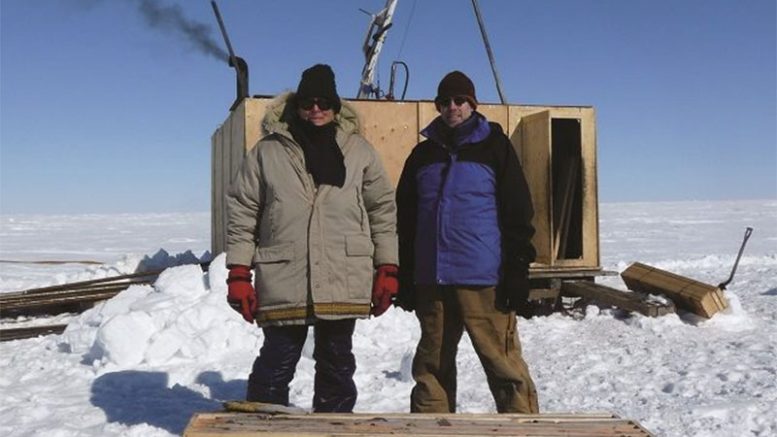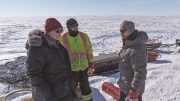When the Diavik diamond mine began production in 2004, there were likely more than a few miners that experienced deep pangs of regret, remembering that they could have had a shot at discovering and owning Canada’s second – and richest – diamond mine.
If only they had listened to Chris Jennings.
Jennings was one of very few people in the 1990s who understood Canada’s potential for diamond exploration and production.
At the time Chuck Fipke and Stu Blusson and BHP Billiton (NYSE: BHP) made the Point Lake diamond discovery (1991) in Lac de Gras, Northwest Territories, Jennings was in London, U.K., trying to raise money to start his own company to explore the same area for diamonds.
He had already tried to convince the heads of exploration at several majors – to no avail – that there was potential for a big find.
“Not only Falconbridge, Superior, Corona, BP – I went to see the heads of Noranda and Teck and told them there are going to be major discoveries,” Jennings said in an interview in early June. “They just laughed at me, they wouldn’t put a cent into it. It’s ironic that Rio Tinto and BHP Billiton as non-Canadian companies are the ones that ended up with the lion’s share of the Northwest Territories mines. You have to have somebody with a vision to believe a story and a lot of companies didn’t have it.”
As luck would have it, while in London, Jennings got a call from Bob Gannicott and Grenville Thomas, hoping he could help them make sense of the Point Lake find.
Jennings advised them where to stake and the rest is history, with Aber Diamond staking the ground that would become Diavik and Jennings bringing in Rio Tinto as a partner.
Falconbridge innovations
Jennings, originally from South Africa, learned a lot about diamonds while working for the Geological Survey of Botswana during the 1960s. At the same time, he had a keen interest in geophysics for mineral exploration, and learned as much as he could about every known geophysical instrument.
At the survey, he worked closely with De Beers geologists, namely Gavin Lamont, whom Jennings describes as likely “the world’s most successful ever diamond geologist.” He learned that, at that time, De Beers relied on soil sampling to make discoveries, and didn’t use geophysics at all.
“Gavin eventually asked me to do a magnetic survey over one of his pipes and eventually over the big Orapa pipe – and clearly these things had geophysical signatures.”
That was knowledge Jennings took with him when he joined Falconbridge as general manager of the company’s African operations in 1970. After waiting several years because he had insider-like knowledge of De Beers’ exploration methods from working at the Survey, he pitched a diamond exploration program to Falconbridge.
The end result was a 50/50 joint venture between Falconbridge and Superior, with programs conducted in Botswana, Canada and the U.S.
In 1974, they started flying airborne surveys in Botswana, finding 70 kimberlites – mostly in areas where De Beers had already explored – in a two-year period.
“We realized that a quicker and effective exploration tool in addition to sampling on the ground would be airborne geophysics,” Jennings said. “In one case, we found a kimberlite where De Beers had a cut line where they’d sampled and not found anything because the kimberlite was well below 60 or 80 metres and covered in Kalahari sand.”
The discoveries of the kimberlites was just the first hurdle.
To evaluate each kimberlite, they would have had to conduct a mini-bulk sample then a larger bulk sample. That would have cost around $10 million each – or $700 million to evaluate all 70.
To help them find a way to prioritize the kimberlites, Jennings got John Gurney, a professor of geochemistry at Cape Town University, involved.
The work that Gurney did using Falconbridge’s sampling information clearly showed that certain garnets were predictive of kimberlites and the more of those garnets the higher the grade of the kimberlite.
“This was a big breakthrough, prediction of economic kimberlites based on mineral chemistry,” Jennings noted. “Work has been ongoing ever since. It’s not just garnets, it’s pyroxenes, it’s spinels, ilmenites – all contribute now to a surer prediction of whether a kimberlite comes from the diamond stability field.”
Falconbridge also did pioneering work on using microdiamonds as a predictive tool for finding bigger, commercial-sized diamonds. Falconbridge’s lab, Lakefield Research, developed techniques to dissolve kimberlite to find the microdiamonds.
Falconbridge later did a deal with De Beers that gave the diamond giant all their data and effectively abandoned diamond exploration.
“We found we were way ahead of them on mineral chemistry,” Jennings recalls.
The acquisition in the early 1980s also put Falconbridge’s world-class diamond exploration team, including Jennings and Hugo Dummett, out of work. Dummett went on to work with BHP, and Jennings with BP.
“We never gave the Gurney report to Chuck, but he knew something was going on and later, through his own research and also hiring one of John Gurney’s people, they also came across the secrets of garnet chemistry,” Jennings says.
Later, when Jennings was senior vice-president at Corona in the late ‘80s, he took money from other exploration budgets to fund a diamond program in the north.
Through a combination of tracing Fipke’s trail and his own exploration work in the Arctic with BP in the 1980s following the same trail of kimberlite indicator minerals west of Lac de Gras, Jennings had a good idea where to look.
“I hired a young geo called Leni Keough, and I tried to get ahead of Chuck – I knew he was out there somewhere in the middle of the Barrens. I told Leni to start in the east and move westward and we hoped to get to the source before Chuck,” he said. “When Leni got to Exeter Lake, she reported excitedly to me that she could actually see lots of red garnets, beautiful purple garnets, which are the diagnostic ones and I couldn’t believe it because normally you have to concentrate the garnets.”
When Jennings asked Corona for $100,000 for an exploration program, they turned him down, and then they fired him. “They lost an opportunity to find a $30-billion mine.”
‘We need a major discovery’
Jennings is now a director of North Arrow Minerals (TSXV: NAR), a junior with several diamond exploration projects in Canada, including the advanced Naujaat project in Nunavut, where fancy yellow and orange diamonds have been recovered.
And despite the current gloom and negativity around the diamond market, he still believes that the industry has a bright future.
“All my life I’ve been an optimist and I continue to be an optimist,” he said. “I think what we need is a major discovery and that will vitalize the diamond industry as the discoveries of Ekati and Diavik did here in Canada.”
Jennings believes there’s potential for new, important discoveries to be made in Canada, Botswana and Angola.
Not all the innovation around diamond exploration and evaluation methods is in the past.
“Chuck today has developed a proprietary method of taking a pyroxene from a kimberlite and he can now predict whether that kimberlite is going to have diamonds up to 50 carats,” Jennings says. “This is part of the innovation that’s happening around the world.”
While some see a threat in lab created diamonds, Jennings doesn’t see the end of natural mined diamonds.
“Production of synthetic diamonds, which requires huge pressures and temperatures, the costs are going to go up and they’re probably going to go up to almost exceed the cost of producing natural diamonds. So I think there’s room for both,” he said.
“Right now, there’s a bit of an oversupply of small diamonds, but coloured diamonds and large diamonds are selling extremely well.”
He adds: “Today, there are well over 2,000 billionaires – they’re in London, New York, San Francisco, Beijing – they are the ones who buy the big, expensive stones and $50 million for a diamond seems to be nothing to them.”
–This article originally appeared in the June 2019 issue of Diamonds in Canada magazine.



Be the first to comment on "Diamond exploration pioneer Chris Jennings sees past market gloom"